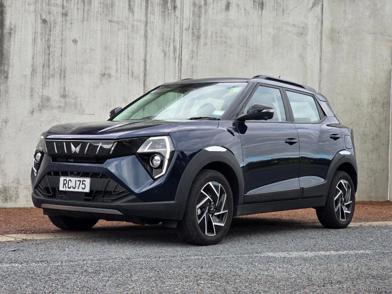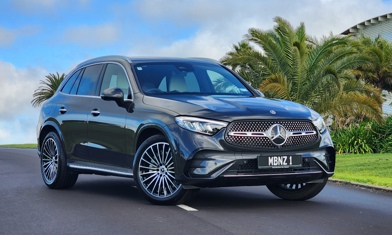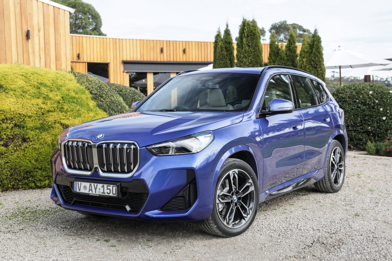There is no denying that when the first-gen Hyundai Kona launched back in 2017 it was a stylistic breath of fresh air. Bold, angular styling that represented one of Hyundai’s earliest attempts at weaning us away from the idea that a “headlight” needed to be a single component, the Kona stood out from the small SUV crowd.
Driving one, however, wasn’t quite as interesting.

Sure, it was perfectly fine and all, but it didn’t really offer anything beyond being a competent transport appliance. In fact, between the bold styling and timid dynamics, some of the more mean-spirited members of the local press labelled it “the interesting car for boring people”. Okay, that was me.
However, the Kona did get progressively more interesting as its life went on, with the addition of an all-electric model and a second generation in 2021 that also added up-spec N-Line models, a hybrid powertrain and, eventually, a brilliantly fun full-fat N model that was genuinely engaging and massively entertaining.

And now at the tail-end of 2023 we have an all-new model that expands on everything (literally; it is bigger than the old one) and takes the bold styling of the original in an even bolder new direction.
The new Kona adopts the fantastically sci-fi inspired “Seamless Horizon” LED DRL light bar with stacked headlights lower down that were first seen on the Staria van, as well as the Z-shaped feature line along its flanks that were first seen on the 4th-gen Tucson from 2020.
Models are largely differentiated by bumpers, with the standard models getting a smooth, simple look with satin silver intakes flanking a blackgrille, while the N-Line models get a larger, more aggressive blacked out version that runs the full width of the front end.

The two are also differentiated by the standard car getting black wheel arches, while the N-Line cars sport body-coloured ones, as well as a prominent wing on its rear hatch.
The Kona Active kicks off the standard range at $42,990 and packs a 110kW/180Nm 2.0-litre petrol four-cylinder engine hooked up to a continuously variable transmission that drives the front wheels, while stepping up to the hybrid Active will cost $52,990 and swaps out the 2.0-litre and CVT for a 104kW/265Nm 1.6-litre four, electric motor and a six-speed dual clutch transmission. High-spec Elite models with both powertrains will be available as well, but prices have yet been nailed down for these.
While the Active models have an impressive amount of standard kit that includes such niceties as wireless phone charging, Apple CarPlay and wireless Android Auto, a big 12.3-inch infotainment touchscreen, adaptive cruise control, automatic headlights and windscreen wipers, LED headlights, a tyre pressure monitoring system and a full suite of driver assists and safety features, the Elite models add projector LED headlights, full leather interior trim, power adjustable seats, interior mood lighting, a Bose audio system and embedded satellite navigation.

Now here’s where things get a touch complicated: where the N-Line was a single model variant in the previous Kona line up, it now features across several grades and powertrains in the line up.
Which means for $49,990 you can get a 2.0-litre CVT Active N-Line and for $59,990 you can have a hybrid Active N-Line with the 1.6-litre/DCT hybrid powertrain. These add the exterior bits and some rather nice leather/alcantara interior trim to the standard Active model’s generous equipment levels.
Got that? Good, because on top of that you can have a Limited N-Line that costs $64,990 and gets, that’s right: yet another drivetrain. This time its a 146kW/265Nm turbo 1.6-litre petrol four-cylinder hooked up to an 8-speed automatic that drives all four wheels. Annnnndd… then there’s the $65,990 Limited N-Line hybrid, that uses the same FWD 1.6/DCT drivetrain as the other hybrid models.

The Limited models get all the standard kit from the Active and Elite variants, as well as the N-Line exterior and interior upgrades, then also add 19-inch alloy wheels, a full-width version of the LED DRL lightbar, blind spot monitoring, a 360 degree camera, remote smart parking, a power tailgate, heated and ventilated front seats, as well as heated rear seats.
You may have noticed that there are no fully-electric or proper N performance models in that line up. This is because, despite the fact Hyundai says the new Kona was primarily developed as an EV, with ICE powertrains a secondary concern, we won’t actually be seeing the EV until next year.
And as for a hot N model? Well, there’s no word on that yet but, c’mon, they are going to. Although we wouldn’t be entirely surprised to see it as a pure electric model, what with the forthcoming Ioniq 5 N and all…

That EV-first claim is pretty obvious on the inside, with the new Kona lifting a lot from the Ioniq 6 and even a few cues from the wider group, like the drive-by-wire steering column-mounted gear selector from the Kia EV9.
While there are some hard plastics around the centre console, the majority of the Kona’s interior is excellent quality, with some superbly comfortable seats being a highlight, particularly in the N-Line models.
The most interesting fact gleaned from the launch drive was the Kona’s deeply impressive blend of ride comfort and handling, as the Kona is now a far more interesting and engaging car to drive.

The ride is deeply impressive for a small (albeit verging on medium now) SUV, with an unflustered plushness that effortlessly shakes off the worst that the often-rugged road around the Coromandel Peninsula could throw at it.
The 2.0-litre/CVT models all get torsion beam rear suspension, while the rest get a multi-link set up and, while ride quality is broadly comparable across both, the multi-link cars do have an edge in handling. It’s not a massive edge though, because this is still a small/medium SUV, remember, but the multi-link set up feels a tad more controlled and confident.
Pitch the Kona into a corner and it will noticeably lean, in keeping with its excellent ride comfort, but the weight transfer is beautifully progressive, while the nose tracks faithfully predictably through.

As far as drivetrains go, the hybrid was the highlight. The 2.0-litre/CVT set up is nicely refined and quiet, but struggles to put much enthusiasm into pulling the Kona around, largely due to the fact the new Kona is bigger and heavier than the old one, the engine’s relatively tiny torque output and, well, that it's saddled with a CVT.
While, on paper, the 146kW/265Nm AWD 1.6-litre turbo would seem to be the pick, the 104kW/265Nm FWD hybrid is actually more responsive and enjoyable to drive, with the more powerful turbo engine having to lug around an extra 40kg thanks to the AWD system.
During our first sampling of the Kona it proved to be generally very impressive, but there were a few niggles, like those areas of hard plastics that bring the cabin's otherwise excellent quality down a wee bit. But the main one was the annoying driver attention monitoring system that constantly chimes and tells you off. While this can easily be turned off, it defaults back to being on when you restart the car.
Overall, however, the excellent ride and more engaging handling makes the Kona a compelling package that is now a far more engaging car to drive.
HYUNDAI KONA
ENGINE: 2.0-litre petrol, 1.6-litre petrol hybrid or 1.6-litre turbo petrol.
POWER: 110kW/180Nm (2.0), 104kW/265Nm (1.6 hybrid) or 146kW/265Nm (1.6 turbo)
GEARBOX: Continuously variable transmission (2.0), 6-speed dual clutch transmission (1.6 hybrid) or 8-speed automatic (1.6 turbo), FWD (2.0 and 1.6 hybrid) or AWD (1.6 turbo)
0-100KM/H: N/a
CONSUMPTION: 7.3l/100km, CO2 166g/km (2.0), 4.3l/100km, CO2 98g/km (1.6 hybrid) or 8.5l/100km, CO2 194g/km (1.6 turbo)
PRICE: $42,990 to $65,990. Elite model prices TBC. Clean Car Rebate/Fee: $1840 rebate (1.6 hybrid), $1495 fee (2.0) and $3105 fee (1.6 turbo).













